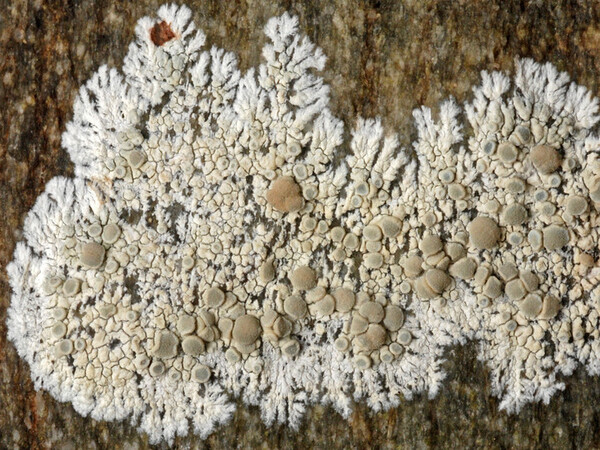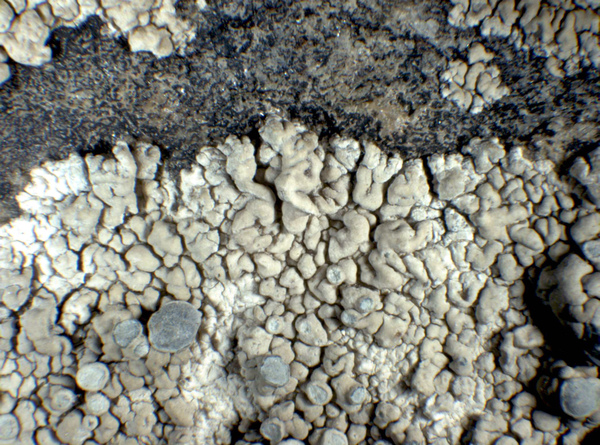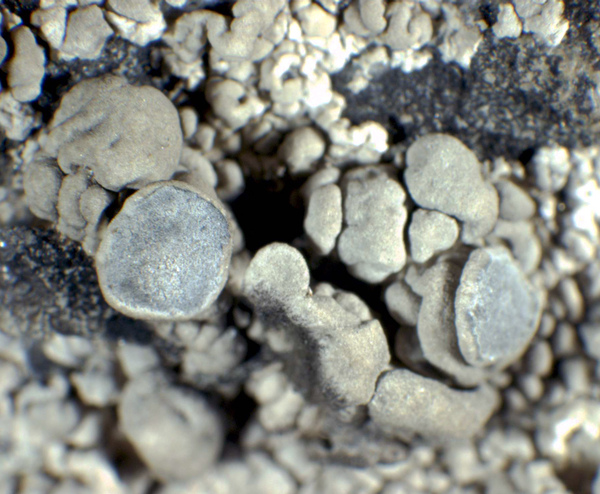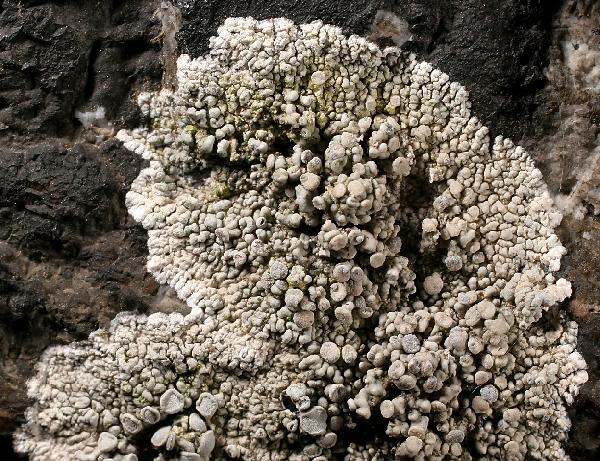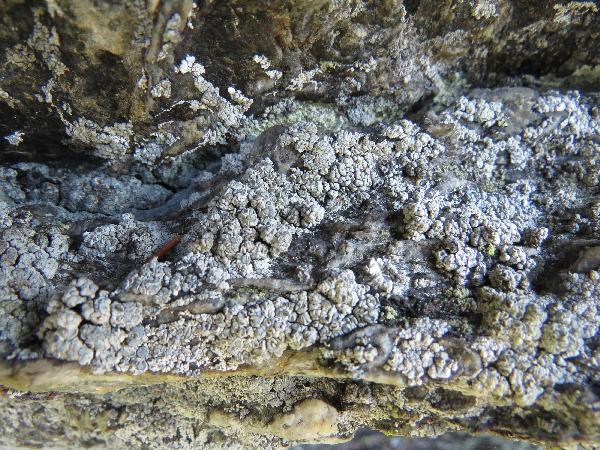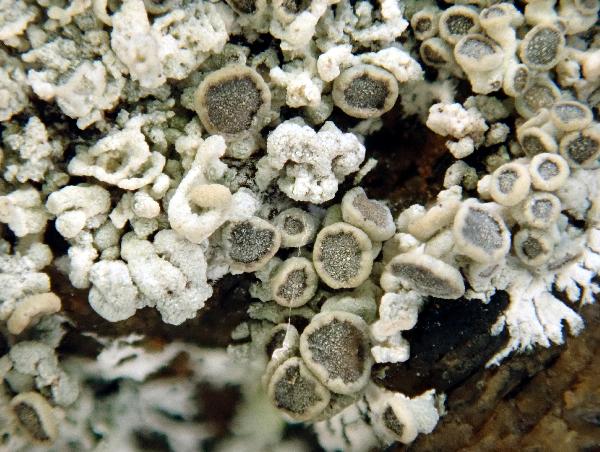Glaucomaria swartzii (Ach.) S.Y. Kondr., Lőkös & Farkas subsp. swartzii
Stud. Bot. Hungar., 61, 1-2: 154, 2019. Basionym: Lichen swartzii Ach. - K. Vetensk.-Akad. Nya Handl.: 185, 1794.
Synonyms: Lecanora glaucoma var. swartzii (Ach.) Nyl.; Lecanora pachycarpa Samp.; Lecanora rupicola var. leucogaea (Ach.) R. Sant.; Lecanora sordida var. swartzii (Ach.) Rabenh.; Lecanora subradiosa auct. non Nyl.; Lecanora swartzii (Ach.) Ach. subsp. swartzii; Zeora sordida var. swartzii (Ach.) Körb.
Distribution: N - Ven, TAA, Lomb, Piem (Isocrono & al. 2004, Isocrono & Piervittori 2008), VA (Piervittori & Isocrono 1999, Matteucci & al. 2015c), Emil (Fariselli & al. 2020), Lig (Watson 2014). C - Tosc (Tretiach & al. 2008), Sar (Roux & Triebel 1994). S - Cal (Puntillo 1996), Si (Grillo 1998, Grillo & Caniglia 2004).
Description: Thallus crustose, episubstratic, rimose to verrucose-areolate, white to cream-coloured, smooth, usually white-pruinose, often forming orbicular rosettes delimited by a white, more or less arachnoid prothallus, sometimes almost placodioid. Areoles flat to finally strongly convex and more or less hollow, thick, ecorticate, the peripheral ones often elongate and more or less radiating. Apothecia lecanorine, constricted at base to almost stalked, 0.3-1.5 mm across, with a brown or grey-brown, but heavily white- or bluish grey-pruinose, flat to convex disc, and a thin, even, smooth thalline margin, with or without an inner, blackish parathecial ring. Thalline exciple with an algal-free, strongly conglutinated eucortex and a more or less loose medullar plectenchyma in inner parts; proper exciple colourless, containing crystals soluble in K; epithecium brown to dark brown, with crystals, the pigment and the crystals dissolving in K; hymenium colourless; paraphyses slightly thickened at tips; hypothecium colourless. Asci 8-spored, elongate-clavate, very thin-walled, with a K/I+ blue, tall tholus penetrated by a faintly amyloid apical cushion, the wall K/I-, surrounded by a K/I+ blue outer layer, Lecanora-type. Ascospores 1-celled, hyaline, ellipsoid, 9-14 x 6-7.5 µm. Photobiont chlorococcoid. Spot tests: thallus K+ yellow, C+ yellow, KC+ orange, P+ pale yellow; apothecial disc (pruina) C+ bright yellow to orange. Chemistry: atranorin (major), chloroatranorin (minor), eugenitol (minor), roccellic acid (major), and sordidone (major).Note: an arctic-alpine lichen found on steeply inclined or rain-sheltered surfaces of siliceous rocks, with optimum near and above treeline; most frequent in the Alps, but also occurring in the high Mediterranean mountains. The subsp. caulescens (J. Steiner) Leuckert & Poelt is known from the Austrian Alps.
Growth form: Crustose
Substrata: rocks
Photobiont: green algae other than Trentepohlia
Reproductive strategy: mainly sexual
In underhangs rarely wetted by rain
Commonnes-rarity: (info)
Alpine belt: rather common
Subalpine belt: common
Oromediterranean belt: rare
Montane belt: very rare
Submediterranean belt: absent
Padanian area: absent
Humid submediterranean belt: absent
Humid mediterranean belt: absent
Dry mediterranean belt: absent
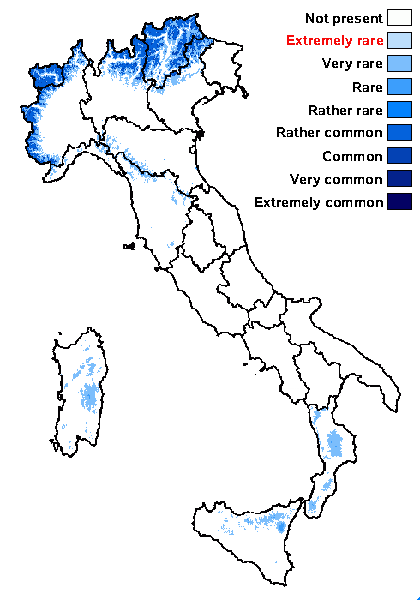
Predictive model
Herbarium samples
Growth form: Crustose
Substrata: rocks
Photobiont: green algae other than Trentepohlia
Reproductive strategy: mainly sexual
In underhangs rarely wetted by rain
Commonnes-rarity: (info)
Alpine belt: rather common
Subalpine belt: common
Oromediterranean belt: rare
Montane belt: very rare
Submediterranean belt: absent
Padanian area: absent
Humid submediterranean belt: absent
Humid mediterranean belt: absent
Dry mediterranean belt: absent

Predictive model
| Herbarium samples |
 DOLICHENS
DOLICHENS
